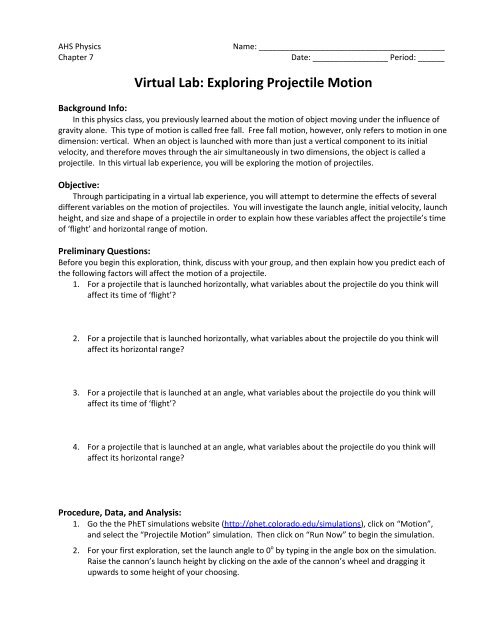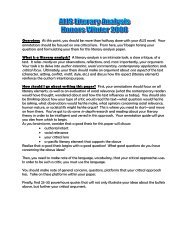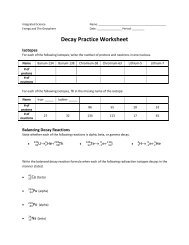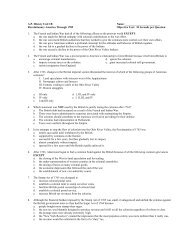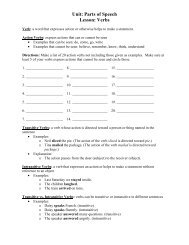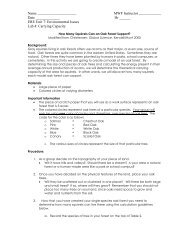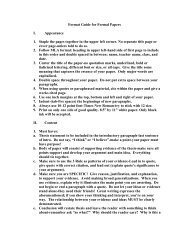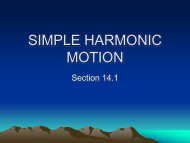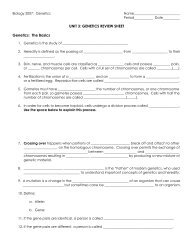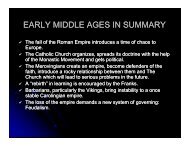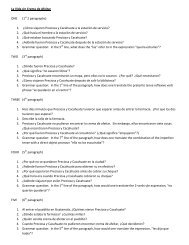Virtual Lab: Exploring Projectile Motion - Arapahoe High School
Virtual Lab: Exploring Projectile Motion - Arapahoe High School
Virtual Lab: Exploring Projectile Motion - Arapahoe High School
Create successful ePaper yourself
Turn your PDF publications into a flip-book with our unique Google optimized e-Paper software.
AHS Physics<br />
Chapter 7<br />
Name: __________________________________________<br />
Date: _________________ Period: ______<br />
<strong>Virtual</strong> <strong>Lab</strong>: <strong>Exploring</strong> <strong>Projectile</strong> <strong>Motion</strong><br />
Background Info:<br />
In this physics class, you previously learned about the motion of object moving under the influence of<br />
gravity alone. This type of motion is called free fall. Free fall motion, however, only refers to motion in one<br />
dimension: vertical. When an object is launched with more than just a vertical component to its initial<br />
velocity, and therefore moves through the air simultaneously in two dimensions, the object is called a<br />
projectile. In this virtual lab experience, you will be exploring the motion of projectiles.<br />
Objective:<br />
Through participating in a virtual lab experience, you will attempt to determine the effects of several<br />
different variables on the motion of projectiles. You will investigate the launch angle, initial velocity, launch<br />
height, and size and shape of a projectile in order to explain how these variables affect the projectile’s time<br />
of ‘flight’ and horizontal range of motion.<br />
Preliminary Questions:<br />
Before you begin this exploration, think, discuss with your group, and then explain how you predict each of<br />
the following factors will affect the motion of a projectile.<br />
1. For a projectile that is launched horizontally, what variables about the projectile do you think will<br />
affect its time of ‘flight’?<br />
2. For a projectile that is launched horizontally, what variables about the projectile do you think will<br />
affect its horizontal range?<br />
3. For a projectile that is launched at an angle, what variables about the projectile do you think will<br />
affect its time of ‘flight’?<br />
4. For a projectile that is launched at an angle, what variables about the projectile do you think will<br />
affect its horizontal range?<br />
Procedure, Data, and Analysis:<br />
1. Go the the PhET simulations website (http://phet.colorado.edu/simulations), click on “<strong>Motion</strong>”,<br />
and select the “<strong>Projectile</strong> <strong>Motion</strong>” simulation. Then click on “Run Now” to begin the simulation.<br />
2. For your first exploration, set the launch angle to 0 o by typing in the angle box on the simulation.<br />
Raise the cannon’s launch height by clicking on the axle of the cannon’s wheel and dragging it<br />
upwards to some height of your choosing.
3. Set the initial speed of the projectile to 10m/s, again by typing in the appropriate box. Click on the<br />
“Fire” button, and note the projectile’s motion. Note the numerical measurements at the top of<br />
the screen. Record the height as “Launch Height 1” in the data table below, and then also record<br />
the time and range measurements as well.<br />
4. Without changing the launch height, change the initial speed to 14m/s, and fire the projectile.<br />
Record the time and range measurements below. Then collect data again for new initial speeds of<br />
18m/s and 22m/s.<br />
5. Now click ‘Erase’ and change the launch height to some new height of your own choosing. Repeat<br />
steps 4 and 5 from this new height. Be sure to record all data in the table.<br />
Launch Height 1: ________m<br />
Launch Height 2: ________m<br />
Initial Speed<br />
(m/s)<br />
Time of ‘flight’<br />
(s)<br />
Horizontal<br />
Range (m)<br />
Initial Speed<br />
(m/s)<br />
Time of ‘flight’<br />
(s)<br />
Horizontal<br />
Range (m)<br />
10 m/s<br />
10 m/s<br />
14 m/s<br />
14 m/s<br />
18 m/s<br />
18 m/s<br />
22 m/s<br />
22 m/s<br />
6. Now that you have explored and collected data about horizontally‐launched projectiles, it is time to<br />
use your data to make generalizations about projectile motion. For a given height, what seem to be<br />
the effects of initial speed on the time of flight of a horizontally‐launched projectile?<br />
For a given height, what seem to be the effects of initial speed on the horizontal range of a<br />
horizontally‐launched projectile?<br />
For a given launch speed, what seem to be the effects of height on the time of flight for a<br />
horizontally‐launched projectile?<br />
For a given launch speed, what seem to be the effects of height on the horizontal range of a<br />
horizontally‐launched projectile?<br />
7. Now click ‘Erase’ and set up your next exploration by moving the cannon back to ground level. Set<br />
the initial speed to 14m/s, and the angle to 30 degrees. Fire the projectile and note the<br />
measurements at the top of the screen. Record the horizontal range and time of ‘flight’ in the data<br />
table.<br />
8. Leaving the initial speed set at 14m/s, repeat the experiment and record results for all of the<br />
additional angles listed in the data table.<br />
Launch Angle (deg) 30 o 35 o 40 o 45 o 50 o 55 o 60 o<br />
Horizontal Range (m)<br />
Time of ‘Flight’ (s)
9. Now that you have explored and collected data about projectiles launched at different angles, it is<br />
time to use your data to make generalizations about projectile motion. For a given launch speed,<br />
what seem to be the effects of launch angle on the time of flight for a projectile?<br />
For a given launch speed, what seem to be the effects of launch angle on the horizontal range of a<br />
projectile? (Be as specific as possible with your answer.)<br />
10. Now click ‘Erase’ and set up your next exploration by setting the angle to 80 degrees and the initial<br />
speed to 14m/s. Fire the projectile and note the measurements at the top of the screen. Record<br />
the horizontal range and time of ‘flight’ in the data table.<br />
11. Leaving the launch angle set at 80 o , repeat the experiment and record results for all of the<br />
additional initial speeds listed in the data table.<br />
Initial Speed (m/s) 14m/s 16m/s 18m/s 20m/s 22m/s<br />
Horizontal Range (m)<br />
Time of ‘Flight’ (s)<br />
12. Now that you have explored and collected data about projectiles launched at different angles, it is<br />
time to use your data to make generalizations about projectile motion. For a given launch speed,<br />
what seem to be the effects of launch angle on the time of flight for a projectile?<br />
For a given launch speed, what seem to be the effects of launch angle on the horizontal range of a<br />
projectile? (Be as specific as possible with your answer.)<br />
13. Now click ‘Erase’ and set up your next exploration by setting the angle to 45 degrees and the initial<br />
speed to 14m/s. Also select ‘tank shell’ from the drop‐down menu that allows you to choose<br />
different objects to fire. Fire the tank shell and note the measurements at the top of the screen.<br />
Record the horizontal range and time of ‘flight’ in the data table, as well as the object’s mass and<br />
diameter.<br />
14. Now change the object that you are firing. Leaving the launch angle and initial speed the same,<br />
repeat the experiment with a variety of different objects of varying shapes and sizes. For each one,<br />
record which object you were using, as well as the other requested data.<br />
Type of Object<br />
Mass of Object (kg)<br />
Diameter of Object (m)<br />
Horizontal Range (m)<br />
Time of ‘Flight’ (s)<br />
Tank Shell
15. Now that you have explored and collected data about projectiles of different shapes and sizes, it is<br />
time to use your data to make generalizations about projectile motion. For a given set of launch<br />
parameters, what seem to be the effects of the object’s shape and size on the time of flight for a<br />
projectile?<br />
For a given set of launch parameters, what seem to be the effects of the object’s shape and size on<br />
the horizontal range of a projectile?<br />
16. Now that you have explored many different variables to determine their effects on motion of<br />
projectiles, it is time to summarize your findings.<br />
For a horizontally‐launched projectile, state which variables do have an effect on the motion of the<br />
projectile, and also explain the type of effect produced by each variable.<br />
For a projectile launched at an angle, state which variables do have an effect on the motion of the<br />
projectile, and also explain the type of effect produced by each variable.


